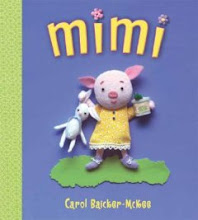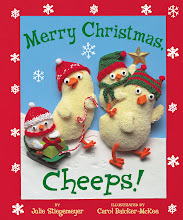
Illustration from my picture book Mimi, Bloomsbury, copyright 2008
I'm back again and apologize for the break. I've been busy with work and family, but also with following and fighting the Consumer Product Safety Improvement Act which I blogged about earlier. I never used to think of myself as an activist, but for the past six months I've been getting my hands dirty with the political process, and I do believe it's possible, though not easy, for ordinary people to join together and have a real impact on the direction of our government.
In the case of this law, I believe it's essential for us regular people to get out there and fight it.
Since I last blogged about CPSIA, there have been a number of developments. Most significantly to me as a children's book author and illustrator, the CPSC ruled that "ordinary books" (i.e., not novelty books or those with spiral or staple bindings) printed since 1985 can be presumed to be lead free and don't have to tested. This is a huge help to publishers of new children's books who can cross at least one giant threat to the kids' book industry off the list, as well as to us authors and illustrators who can worry less about their recent books being pulled from school, library, and bookseller shelves, and maintain hope that there will continue to be publishers out there to buy our new manuscripts. (Plus we can continue to donate copies of our books to literacy groups and libraries, as well as give copies to friends' kids without looking over our shoulders for the lead police.)
The other ruling that has made me sigh with relief is the one that items made 100% from a handful of materials that are known for sure to be lead-free can also be sold without needing to be tested. These materials include most textiles, threads, and yarns (metallics, vinyls, treated leathers, etc. are excluded), and untreated/unpainted wood as well as those "commonly" used materials for children's toys and clothing like 14 carat gold, diamonds, rubies, pearls, etc. (I am not kidding about these last materials -- see the list of safe materials on p. 8 of the CPSC's Guide for Small Businesses, Resellers, Crafters and Charities.) My kids and I like to make quilts and afghans for Project Linus and I knit teeny tiny hats for preemies, and it really distressed me to think I'd never be able to donate things like that again. (Neither my quilts nor the hats has any fasteners, and while in the past I've helped kids make quilts with pictures they'd drawn with fabric pens or crayons which aren't exempt from testing, I guess I can shift my decorative approach.)
But on the whole, the rulings and clarifications have done little to ease my concerns or those of other small businesses, crafters, consumers of small batch items, and yes, kids themselves.
Although the CPSC stayed the testing requirement for a year and has ruled that resellers like thrift stores and people having yard sales don't have to test at all, the stays provide only the illusion of relief. First, none of the 50 states' attorneys general are bound to abide by CPSC's rulings, and neither are the private plaintiffs' lawyers authorized to pursue cases against "wrongdoers." Second, everything you manufacture (and you're a manufacturer if you so much as add a ribbon to a hair bow and try to give it away) still has to comply with the lead and phthalate limits - and how can you tell for certain that something is in compliance if you don't test? Many thrift stores like Goodwill and the Salvation Army are pulling all or most children's products from their stores, refusing donations, and turning away the families that really need these items in this troubled economy. (See this front page article from last week's Boston Globe if you don't believe this would happen.) Finally, when the stay ends a year from now, the destructive testing provisions will still go into effect for all children's products except the small percentage that have been given a reprieve - the costs of that testing will force the remaining small businesses that have limped along this year into oblivion (and the destructive testing will obviously signal the end of one of a kind products).
You can read about the myriad of consequences in more detail than I can provide here at several excellent blogs, including Walter Olson's Overlawyered, Rick Woldenberg's business site, Learning Resources, Inc. and the blog of used bookseller Valerie Jacobsen (she's also a homeschooling mother of eleven - makes me feel like a slug). I'm also awed by the encyclopedic coverage of the law and vintage book fallout news provided by Deputy Headmistress (another homeschooling mom -- slacker -- she "only" has seven kids. How do these women accomplish so much?). And check out the Adventures of Whimsical Walney, who unfortunately has been forced to shutter her small business because of the law; she offers lots of help for people who want to contact their congressmen but don't know what to say or how to find addresses and phone numbers, as well as links to the major players covering different things affected by the law (see her 2-28-09 posting).
There was finally an article in my local paper, the Pittsburgh Post-Gazette about the law the other day. (Read it here.) It's by Brian O'Neill, a columnist I really enjoy, who has a good track record of achieving reforms locally, so I was especially glad to see it. He only covered the dirt bike angle (the youth dirt bike and ATV industry is basically eliminated by this law, since lead is a necessary component in some of the alloys used to make them). But since he failed to address the parts of the law that have me utterly up in arms these days (like equipment and supplies for special needs kids and vintage books), I had to send him rather a long letter begging him to write about those issues too. I haven't heard back from him yet (urk, he's probably still trying to get through my missive), but I'm hopeful he'll take up the fight, along with his battle to restore passenger rail service to at least its inadequate-but-way-better-than-now status. (That's a battle I care about too.)
Here's an excerpt from my letter to him:
Libraries and used booksellers are similarly paralyzed and the threat to the history of children's literature is dire. The CPSC granted another last minute exemption for "ordinary books" (i.e., not novelty books or inexpensive paperbacks bound with staples) printed after 1985 (it's apparently really just a coincidence that the magic year is 1984 -- that's when lead was banned in printing inks) because publishers were able to provide a wealth of scientific evidence that the inks, glue, papers, chipboard they currently use don't have lead in them. There may, however, be trace amounts of lead in the inks used in older books or in metal staples -- so EVEN IN THE ABSENCE OF A SINGLE CASE OF LEAD POISONING FROM BOOKS and plenty of evidence that lots of exposure to books is associated with better outcomes for kids -- the CPSC has advised libraries and booksellers to "sequester," test or discard books printed before 1985, novelty books, and wire, plastic or staple-bound books. They did grant an exclusion for books and other collectibles "of sufficient age or value that they would not be given to a child." This situation is a calamity as far as I'm concerned (or would be if people were complying. Libraries, for instance, many faced with the loss of huge parts of their collections, have mostly just decided to do an about face and take the position that the law doesn't mean them. Good for them.) The vast majority of older children's books do not fall in the category of being so valuable they wouldn't be given to a child (I rarely spend more than $5 per volume to expand my collection), and most are out of print. They couldn't or wouldn't be likely to be reprinted either, for many reasons. The old printing plates were usually destroyed when a book went out of print and the text and illustrations of older books are rarely available electronically, so books would have to be scanned (an expensive and time-consuming proposition) or re-typeset and/or re-illustrated. There are other reasons old books wouldn't/aren't typically reprinted: tastes have changed, there are thousands to millions of new good manuscripts awaiting or emerging for publication, it can be extraordinarily difficult to track down the holders of the copyrights (the authors and illustrators or their heirs typically), books have to compete with other media and have been hurt by the bad economy -- so it's likely most of the history of children's literature will be lost, particularly the books printed in the 20 years or so before 1985 that are not possibly considered to be special collectibles. The loss would be terrible for many adults -- illustrators and writers value the old books as sources, mixed media artists repurpose components of damaged books, historians use them to trace trends and attitudes, ordinary people delight in the memories they evoke. But the loss for children would be even greater. The content of an old book is no more made worthless by a newer one than your first child is made obsolete by your second born. In particular, poetry, nonfiction of all sorts, and anthologies would be severely depleted by this law with nothing to replace them. In addition, happening upon a favorite book from childhood is often the event that spurs a parent to start reading to a child, and this may be an especially important incentive to start sharing books in disadvantaged populations, for whom the benefits of books can be particularly great.
Okay, I'm running on at the fingers again, so I'll stop for now. But my pledge is that for the foreseeable future, or until this law is substantially changed or repealed, I'm going to blog most days about a vintage book that's threatened by this law, while also looking at the law (what makes sense, what doesn't), thinking about how best to combat it, and directing you to other good information. I'll also occasionally feature a useful product, small business, child, consumer, or taxpayer affected by the law. If you have any suggestions/requests, let me know.
I'm going to take a few minutes now to try to figure out how to add the "Say No to CPSIA" button to my blog (I'm such a techno idiot at times), add a list of CPSIA links, and do a little more blog housekeeping like that. And then I have to get back to my work -- but later today, I'll post about one of my all time favorite kids' books: Lotta on Troublemaker Street by Astrid Lindgren and illustrated by Ilon Wikland.




















4 comments:
Great post- and I love your illustrations!
"The content of an old book is no more made worthless by a newer one than your first child is made obsolete by your second born. "
Thank you for this quote. It expresses the situation so well. I don't think that the powers that be and their staffers really have any idea of what they are in the process of trashing.
Thanks for a wonderfully written post. I am still finding that the general public still doesn't know about the CPSIA. Such a shame...
Love your books and illustrations, btw!
Thanks for your nice comment. It is sad how few people even know about this law - but I'll keep educating folks, even if I have to do it one person at a time. I keep hoping common sense will prevail, but I am worried it won't.
Post a Comment